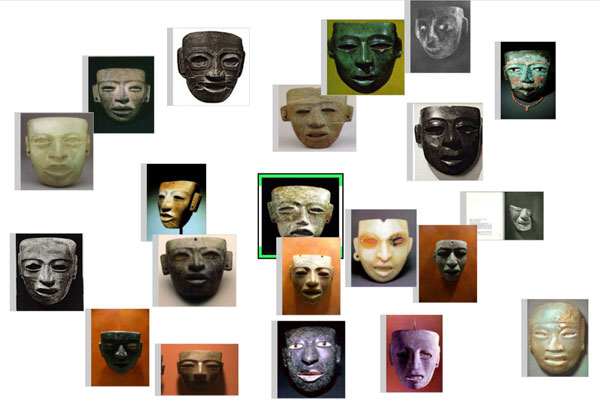News & Events
Eye on digital humanities
National Endowment for the Humanities grant awarded to visual analysis database project
Art history associate professor Rex Koontz remembers distinctly how one of his mentors researched artifacts and ancient artworks – by going through tall stacks of hardcover books, identifying images and photos, then placing them on the floor of his office to compare them.
The Internet made this cumbersome research method a thing of the past, but did not exactly replicate it. Instead of relying on what the eye sees, Internet searches focus on word “tags” and verbal descriptions.
Koontz and a UH research team, including Dan Price, a research assistant professor in The Honors College, has developed the Visual Web Interface for Researchers (Vwire), a new online tool that allows visual sorting, comparing and categorizing rather than word-based organization.
“Vwire is a tool that allows researchers to save visual knowledge,” said Koontz, director of UH’s School of Art. “It also can be used to begin a conversation about visual analysis. Because it’s online, it can promote discussions among researchers across disciplines from all areas of the world.”
The team recently received a $50,000 National Endowment for the Humanities (NEH) Digital Start-Up Grant for the project, “Vwire: Digital Content Management through Spatial Arrangement – A Tool for Visual Argumentation in the Humanities.”
Assisting with this project are Jerome Crowder, assistant professor at the University of Texas, Medical Branch at Galveston and Ioannis Konstantinidis, who holds a doctorate in mathematics and is a research development officer with UH’s Texas Learning and Computation Center (TLC2.)
Vwire allows images to be uploaded into a visual database, grouped together for side-by-side analysis, saved as collections and shared among students and researchers. Students and researchers also can participate in the online Vwire community that facilitates academic dialogue about shared images.
Vwire is a prototype and will not be available for public use until 2012. The NEH-funded phase of Vwire’s development is focused on a collection of ancient stone masks from the Teotihuacan archaeological site in the central Mexico region known as the Valley of Mexico. Ten to 12 art historians and archaeologists will use Vwire to analyze the collection over an 18-month period.

At the conclusion of their analysis, the scholars will be interviewed about the decisions they made as they categorized these masks. Each participant also will have the opportunity to see how the rest of the group organized these masks and engage in cross-disciplinary discussion.
Student Lauren Lovings recently provided support to the project through UH’s Summer Undergraduate Research Fellowship program. She prepared textual information about the Teotihuacan masks for the project’s participating scholars. Lovings also used Vwire to develop an exhibition focused on eight Teotihuacan masks. She will showcase this work this fall at UH’s School of Art.
“This tool can be helpful to students who are involved in visual fields of study,” said Lovings, a senior art history and French major. “When I'm writing an essay for an art history course, I'll have the images that I'm using and the arguments that I want to make spread out on a table to visualize the order in which I want to make my arguments. Vwire allows students to do this in a digital space. One of the greatest features about Vwire is that students can organize the images in a specific way, save that organization and try out different organizations. Vwire allows researchers to make as many visual arguments as they want to have.”
Lovings wasn’t the first student to use Vwire. It recently was tested in one of Koontz’ art history courses that focused on Mesoamerican culture. He used the tool to illustrate how Mesoamerican tripods were mislabeled in previously published research. Vwire’s capability to compare similar objects visually allowed students to see how these tripods were created by different cultures, while previous research indicated they were only from one source.
“Visual analysis is very important for students in critical social sciences. Making sense of our visual world is absolutely crucial,” Koontz said. “A tool such as Vwire can help students and seasoned researchers develop a fine eye. Most importantly, it can be used across disciplines including design, sociology, anthropology, art history and others.”
- Mike Emery